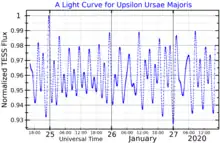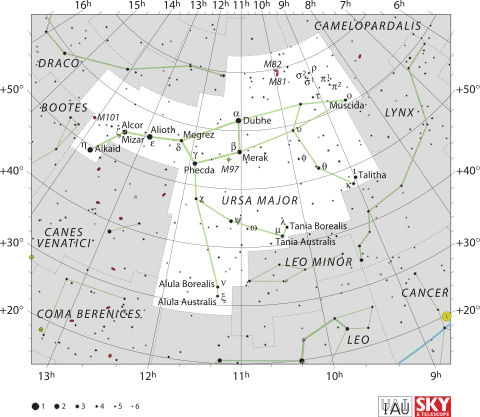Upsilon Ursae Majoris
Upsilon Ursae Majoris, Latinized from υ Ursae Majoris, is a binary star[12] in the northern circumpolar constellation of Ursa Major. It is visible to the naked eye with an apparent visual magnitude of +3.79.[4] Based upon an annual parallax shift of 13.24 mas,[1] it is located roughly 246 light-years from the Sun.

 | |
| Observation data Epoch J2000.0 Equinox J2000.0 (ICRS) | |
|---|---|
| Constellation | Ursa Major |
| Right ascension | 09h 50m 59.35700s[1] |
| Declination | +59° 02′ 19.4486″[1] |
| Apparent magnitude (V) | 3.68 – 3.86[2] |
| Characteristics | |
| Spectral type | F2 IV[3] |
| U−B color index | +0.09[4] |
| B−V color index | +0.29[4] |
| Variable type | δ Sct[2] |
| Astrometry | |
| Radial velocity (Rv) | 27.3±4.1[5] km/s |
| Proper motion (μ) | RA: +42.97[1] mas/yr Dec.: −23.62[1] mas/yr |
| Parallax (π) | 28.06 ± 0.20 mas[1] |
| Distance | 116.2 ± 0.8 ly (35.6 ± 0.3 pc) |
| Absolute magnitude (MV) | +1.11[6] |
| Details | |
| υ UMa A | |
| Mass | 1.57[7] or 2.20[3] M☉ |
| Radius | 2.79±0.40[8] R☉ |
| Luminosity | 29.5[9] L☉ |
| Surface gravity (log g) | 3.79±0.14[7] cgs |
| Temperature | 7,211±245[7] K |
| Rotation | 1.2±0.30 d[8] |
| Rotational velocity (v sin i) | 124.2[10] km/s |
| Age | 1.168[7] Gyr |
| υ UMa B | |
| Mass | 0.44[3] M☉ |
| Other designations | |
| A: 29 Ursae Majoris, BD+59°1268, FK5 368, HD 84999, HIP 48319, HR 3888, SAO 27401[11] | |
| Database references | |
| SIMBAD | data |
The primary member of the system, component A, is an F-type subgiant star. It is a Delta Scuti variable[8] with a period of 0.1327 day and an amplitude of 0.050 magnitude.[14] With an estimated age of 1.168[7] billion years, it is spinning rapidly with a projected rotational velocity of 124.2 km/s[10] and a rotation period of 1.2 days.[8] The star has about 1.57[7] times the mass of the Sun and 2.79[8] times the Sun's radius. (De Rosa and colleagues give a mass estimate of 2.2[3] times the Sun's mass.) It is radiating around 29.5[9] times the solar luminosity from its outer atmosphere at an effective temperature of 7,211 K.[7]
The companion, component B, is a magnitude +11.0 star.[12] As of 2008, it has an angular separation of 11.78 arcseconds along a position angle of 295.4°. This corresponds to a projected separation of 419.8 AU.[3] It has a mass around 40% that of the Sun.[3]
Naming
With τ, h, φ, θ, e and f, it composed the Arabic asterism Sarīr Banāt al-Na'sh, the Throne of the daughters of Na'sh, and Al-Haud, the Pond.[15] According to the catalogue of stars in the Technical Memorandum 33-507 - A Reduced Star Catalog Containing 537 Named Stars, Al-Haud were the title for seven stars : f as Alhaud I, τ as Alhaud II, e as Alhaud III, h as Alhaud IV, θ as Alhaud V, this star (υ) as Alhaud VI and φ as Alhaud VII .[16]
In Chinese, 文昌 (Wén Chāng), meaning Administrative Center, refers to an asterism consisting of υ Ursae Majoris, φ Ursae Majoris, θ Ursae Majoris, 15 Ursae Majoris and 18 Ursae Majoris. Consequently, the Chinese name for υ Ursae Majoris itself is 文昌一 (Wén Chāng yī, English: the first Star of Administrative Center.).[17]
References
- van Leeuwen, F. (2007), "Validation of the new Hipparcos reduction", Astronomy and Astrophysics, 474 (2): 653–664, arXiv:0708.1752, Bibcode:2007A&A...474..653V, doi:10.1051/0004-6361:20078357, S2CID 18759600.
- Samus, N. N.; Durlevich, O. V.; et al. (2009), "VizieR Online Data Catalog: General Catalogue of Variable Stars (Samus+ 2007–2013)", VizieR On-line Data Catalog: B/GCVS. Originally Published in: 2009yCat....102025S, 1, Bibcode:2009yCat....102025S.
- De Rosa, R. J.; et al. (2013), "The VAST Survey – III. The multiplicity of A-type stars within 75 pc", Monthly Notices of the Royal Astronomical Society, 437 (2): 1216, arXiv:1311.7141, Bibcode:2014MNRAS.437.1216D, doi:10.1093/mnras/stt1932, S2CID 88503488.
- Mermilliod, J.-C. (1986), "Compilation of Eggen's UBV data, transformed to UBV (unpublished)", Catalogue of Eggen's UBV Data, SIMBAD, Bibcode:1986EgUBV........0M.
- de Bruijne, J. H. J.; Eilers, A.-C. (October 2012), "Radial velocities for the HIPPARCOS-Gaia Hundred-Thousand-Proper-Motion project", Astronomy & Astrophysics, 546: 14, arXiv:1208.3048, Bibcode:2012A&A...546A..61D, doi:10.1051/0004-6361/201219219, S2CID 59451347, A61.
- Ammler-von Eiff, Matthias; Reiners, Ansgar (June 2012), "New measurements of rotation and differential rotation in A-F stars: are there two populations of differentially rotating stars?", Astronomy & Astrophysics, 542: A116, arXiv:1204.2459, Bibcode:2012A&A...542A.116A, doi:10.1051/0004-6361/201118724, S2CID 53666672.
- David, Trevor J.; Hillenbrand, Lynne A. (2015), "The Ages of Early-Type Stars: Strömgren Photometric Methods Calibrated, Validated, Tested, and Applied to Hosts and Prospective Hosts of Directly Imaged Exoplanets", The Astrophysical Journal, 804 (2): 146, arXiv:1501.03154, Bibcode:2015ApJ...804..146D, doi:10.1088/0004-637X/804/2/146, S2CID 33401607.
- Korzennik, S. G.; et al. (April 1995), "Nightly variations of nonradial oscillations in the Delta Scuti star upsilon Ursae Majoris", Astrophysical Journal, Part 2, 443 (1): L25–L28, Bibcode:1995ApJ...443L..25K, doi:10.1086/187827.
- Balona, L. A.; Dziembowski, W. A. (October 1999), "Excitation and visibility of high-degree modes in stars", Monthly Notices of the Royal Astronomical Society, 309 (1): 221–232, Bibcode:1999MNRAS.309..221B, doi:10.1046/j.1365-8711.1999.02821.x.
- Schröder, C.; Reiners, Ansgar; Schmitt, Jürgen H. M. M. (January 2009), "Ca II HK emission in rapidly rotating stars. Evidence for an onset of the solar-type dynamo" (PDF), Astronomy and Astrophysics, 493 (3): 1099–1107, Bibcode:2009A&A...493.1099S, doi:10.1051/0004-6361:200810377
- "ups UMa", SIMBAD, Centre de données astronomiques de Strasbourg, retrieved 2017-02-22.
- Eggleton, P. P.; Tokovinin, A. A. (September 2008), "A catalogue of multiplicity among bright stellar systems", Monthly Notices of the Royal Astronomical Society, 389 (2): 869–879, arXiv:0806.2878, Bibcode:2008MNRAS.389..869E, doi:10.1111/j.1365-2966.2008.13596.x, S2CID 14878976.
- MAST: Barbara A. Mikulski Archive for Space Telescopes, Space Telescope Science Institute, retrieved 8 December 2021.
- Rodríguez, E.; et al. (June 2000), "A revised catalogue of delta Sct stars", Astronomy and Astrophysics Supplement, 144 (3): 469–474, Bibcode:2000A&AS..144..469R, doi:10.1051/aas:2000221.
- Allen, Richard Hinckley (1899), Star-Names and Their Meanings, New York: G. E. Stechert, p. 442.
- Rhoads, Jack W. (November 15, 1971), Technical Memorandum 33-507-A Reduced Star Catalog Containing 537 Named Stars (PDF), Jet Propulsion Laboratory, California Institute of Technology.
- (in Chinese) AEEA (Activities of Exhibition and Education in Astronomy) 天文教育資訊網 2006 年 6 月 16 日